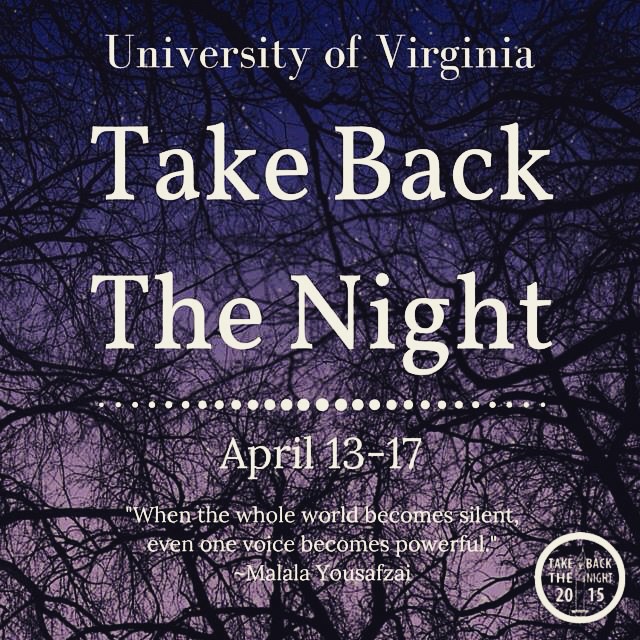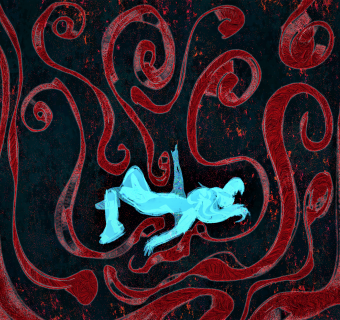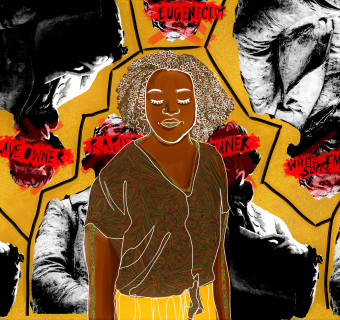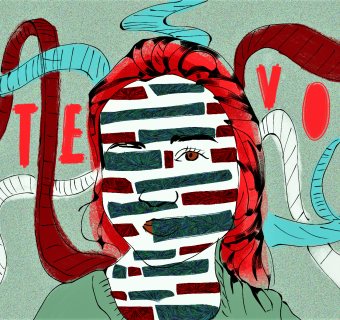
Organized by the Sexual Violence Prevention Coalition and supported by the Gender Violence and Social Change program at the Maxine Platzer Lynn Women's Center and the Office of the Dean of Students, Take Back The Night (TBTN) is an annual series of events that occurs mid-April at U.Va. The purpose of the week is to "educate the public, support survivors, and make a loud call to end gender violence in our community," according to the Not on Our Grounds website. The following are recaps of three events among the many during the Take Back the Night Week for 2015.
A Discussion on Sexual Misconduct Policy and Law
Kimia Nikseresht
As a part of “Take Back the Night”, a discussion took place on April 14 addressing the legal terms of the interim sexual misconduct policy at U.Va. Primarily, the event intended to reach those that would be impacted by the policy changes, presenting the options a victim or bystander now have in the University’s recently altered sexual misconduct procedure. The panel consisted of U.Va. Associate Dean of Students Nicole Eramo, project coordinator Emily Renda and Professor of Criminal Law at the U.Va. Law School Anne Coughlin. With their collective expertise, they aimed to explain the recent policy changes in order to make the legal document more accessible and understandable by the undergraduate student body. The discussion emphasized the use of the term “affirmative consent,” as opposed to “effective consent” in the new policy. Affirmative consent requires actively expressing agreement, and does not consider lack of resistance or mere silence as consent. Furthermore, affirmative consent can be withdrawn at any point throughout the experience. While the slight shift in terminology may not seem like much, it is fundamental to the procedures that follow, as lack of “affirmative consent” is now essential tothe U.Va. definition of sexual misconduct. Understanding this term is important, as it determines when an act of sexual misconduct has occurred and should be reported. When an incident is reported, the steps that follow have been altered to fit the “single investigator model.” In this model, rather than directly confronting one another in court, one qualified individual (generally a lawyer) is deemed responsible for collecting evidence. This person extensively engages with all parties involved, asking questions and reporting their answers. By going back and forth between the accused and the alleged victim, they are effectively cross-examined without ever being forced to confront each other face to face. In other words, victims will not have to experience the psychological trauma and emotional distress caused by forcibly interacting with their attacker. In addition, the panel addressed the role of the Honor Code in relation to sexual misconduct. Renda explained the policy intends to encourage reporting sexual misconduct in order to create a safer U.Va. as a whole. The “single sanction model” that the University has implemented for decades, states that students who are guilty of cheating or stealing will be expelled from the University. While this may be effective on some accounts, it has been proven to discourage reports of sexual misconduct, as many victims do not want, or even fear, the expulsion of their perpetrator. So they choose instead, to not report the incident at all, as a way to avoid such punishment. However, by considering a wide range of sanctions for each specific case, as evaluated in severity, impact, prior misconducts of the accused, and other factors, victims feel more comfortable approaching the University or the police about an incident While these changes are carefully constructed to create a better U.Va., as one student pointed out, they do very little to address the greater U.Va. culture and the social stigma associated with reporting sexual misconduct. “What really gets glossed over in these policy revisions is the immense amount of social stress this can put on a victim, especially in our victim-blaming culture,” WGS student Kendall Siewert explained. “The social stigma associated with sexual misconduct is, in fact, a major underlying concern of students in the efforts to improve the climate around Grounds and the discussion of sexual misconduct between the administration and the student body.” Overall, the main purpose of the new policy is to address sexual misconduct in the most extensive, yet sensitive way, without ever losing sight of the victim’s healing process as they come to terms with often traumatic experiences. In this way, while there is always room for improvement, the policy is a step in the right direction for the University of Virginia.
Take Back the Night Rally
Agnes Filipowski
Before Gordon Braxton (McIntire 2002) returned to Grounds to speak at the rally on April 16 for Take Back the Night this year, he had already experienced much discussion regarding media coverage of injustice at U.Va. In his office with co-workers and on social media with fellow alumni, he engaged in conversations about events from the past school year that garnered national attention – the Rolling Stone article about alleged gang rape at a fraternity, and later, the apparent use of excessive force against a black undergraduate student. Based on these recollections, Braxton emphasized the need for all of us to recognize the similarities (as well as acknowledge the differences) between fighting for racial justice and fighting against sexual violence and to then, in turn, join forces.
“My observation was, at first, I found a bit frustrating and a little disheartening that there should be such separation between social justice issues,” he said. “After all, these are movements that are working toward a critical mass – a critical mass that could push the violent folks out of our community. This is going to become easier to do if we decide to come out of our individual silos and work across issues.”
The commonalities between the two movements is what initially inspired his undergrad involvement in organizations such as One Less and his work with Claire Kaplan in the Gender Violence and Social Change program (then called Sexual and Domestic Violence Services) at the Maxine Platzer Lynn Women’s Center. Braxton came to U.Va. with the intent of advocating for racial equality in his work, but said that as he listened to those who were doing anti-violence advocacy, he found they were ultimately supporting the same issues that he was. “As a man, I obviously found some of it to be threatening, but I worked through it because I realized I had already accepted a lot of things that they were trying to tell me,” he said. “I accepted that America wasn’t a perfect meritocracy. I had already accepted that the attitudes that we keep behind closed doors sometimes manifest themselves in ways that had real consequences in people’s lives. I had already accepted that the culture shielded and minimized and normalized certain brands of violence.” During part of his speech, Braxton decided to conduct a quiz of sorts to more vividly illustrate the overlap. He gave his audience quotes from famous activists – Dr. Martin Luther King Jr., Mahatma Gandhi, Geraldine Ferraro and Nellie Stone Johnson – and asked whether they could identify what the quote was supporting – racial justice or women’s rights.
- “If America is to remain a first class nation, it can no longer have second class citizens.”
- “A ‘No’ uttered from the deepest conviction is better than a ‘Yes’ merely uttered to please, or worse, to avoid trouble.”
- “We’ve chosen the path to equality; don’t let them turn us around.”
- “I’m not going to quit. There is too much to do. People need jobs, equality, education. We still need to organize to learn how the economics and politics drive everything in life.”
Braxton pointed out that “when we strip the words of activists from their contexts, we find that everybody is fighting for the same thing. Their words are virtually indistinguishable from one another.” His inspiring speech called on the U.Va. community to not only make the connections between these two movements, but to take action, even if in small ways. He gave examples of what audience members could do that would not be time-consuming, such as “the next time that you’re in an intimate encounter […], take the time to make sure that your actions are consensual” and to not laugh at comments or jokes that make light of “taking advantage of a woman.” These small actions are what U.Va. Associate Dean of Students Nicole Eramo described earlier at the rally as “Green Dot behaviors.” The Green Dot program is based on the intent that every Red Dot (representing a choice by an individual in a moment of time to commit an act of power-based personal violence–somewhat the way the spread of a virus might be illustrated on a map) will eventually be replaced with a Green Dot (representing a choice made by an individual or group of individuals in a moment of time, to interrupt or prevent an act of power-based personal violence). In her daily interaction with survivors of sexual assault, Eramo said that she can’t help but carry “those [stories] home, every day and that’s not an easy thing to do and when you do that every day, you start to lose hope and think, ‘how are we going to end this violence, how can we do this’?” When she met Dorothy Edwards, Executive Director of Green Dot a few years ago, she found hope.
“Some of the simple things we can do as a community, when you raise awareness and teach people how to see things and do things to be proactive, gave me hope and made me feel like, ‘Hey, maybe we can do this, maybe we can do this in our community.’"
Green Dot’s message encompasses two parts:
- Violence doesn’t belong in our community.
- And we all have a place to do our part; we all need to do our part to end violence here.
“If we internalize that, if we take that home with us and not let the stories that we hear tonight at the vigil overwhelm us and overwhelm our hope, if we do that, we can scare those folks out of our community,” Eramo said. “We can tell them, ‘You don’t belong in our community, this is ours, and you will not perpetrate violence here. We won’t let it happen to another girl, another man here.’”
Day of Healing - Yoga
Camille Kidwell
 Photo by: Camille Kidwell
Photo by: Camille KidwellOne of the many events during the "Day of Healing" following the Take Back the Night Rally, March and Vigil was yoga in one of the gardens on the Lawn.
After the tumultuous year that the University of Virginia has faced, the student body has been in need of a time for unification and rest. “Take Back the Night’s Day of Healing” held on April 17 provided this outlet for many students, offering numerous opportunities such as women’s self-defense, drop-in counseling, relaxation yoga and glass art creation workshops. Each event provided a space where women could feel empowered and unafraid to share their personal stories or feelings of vulnerability. The events were designed to highlight that there are many means of support available while we are in need and that there are mechanisms to begin the healing process. While this healing often takes time, each program emphasized that feelings of peace and power can be felt again and that these feelings are what we, as women, deserve to feel, despite any circumstance. These events were all intended to support the “Take Back the Night” initiative, to promote awareness of gender-based violence at U.Va. and the Charlottesville area, in order that it be stopped. I personally had the pleasure of attending relaxation yoga. It was a beautiful day in Garden Five, as myself and 16 other university students entered to enjoy the sunshine and take part in a morning yoga session. The event could not have been more picturesque; flower petals were falling softly from the trees and birds were chirping as the splendor of creation glowed around them. The surroundings were symbiotic to the feelings of relaxation and awe the event was creating, as participants took part in poses such as “peaceful” to relate the body and the mind. In addition, yoga leader Lily provided encouraging comments throughout the session, emphasizing that there was no need to “…think about the future or the past… just now.” Day of Healing Committee Chair Haley Swartz, explained a bit more about the event and why it was so important to the program. Swartz stated, “The mind, body and soul are all necessary in the healing process, being simultaneous factions that you cannot separate. This event nurtures all three through physical, mental, and emotional connections.” In addition, because it was a group event where many students could participate with one another, it was a mechanism to “reclaiming oneself communally.” As a group, students were able to process their thoughts internally, yet externally feel support through the presence of 15 others. This feeling of care and encouragement is paramount to the healing process and was tied together seamlessly that morning. The event ended with conversation among bagels and fruit, as individuals enjoyed one another’s company under some shady trees. Viewing the smiles and listening to the laughter among the group, it was quite evident to all that the session provided exactly what it intended to give: a wonderful, relaxing and restful morning to reclaim the mind and the body, as well as to support the Take Back the Night initiative and what it is doing for this University.






